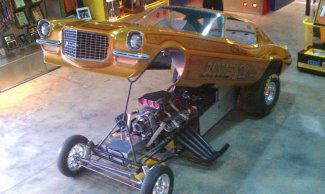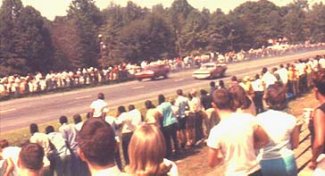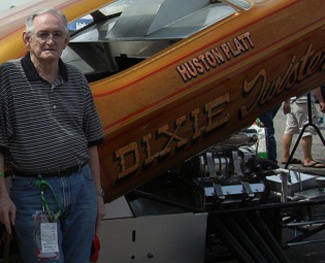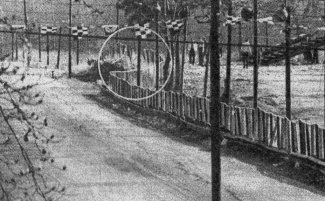
Huston Platt's famed Dixie Twister funny car sits in a place of honor in the Georgia Racing Hall of Fame in Dawsonville, Georgia. Photo courtesy GRHOF
By Angela Williamson
Posted in Feature Stories 1/27/12
The Georgia Racing Hall of Fame in Dawsonville, Georgia has seen its share of “hero” cars. And the newest addition to the list is currently on exhibit at the GRHOF.
The “Dixie Twister”, and its driver, Huston Platt, went through many years of pain and suffering before it was finally realized that they too, deserve a spot in the hero arena.
The “Dixie Twister” was involved in what is still known as the worst racing tragedy in U.S. history. It was an accident that forever changed the safety regulations of all of motorsports.
On March 2, 1969, Platt was racing the Dixie Twister at the Yellow River Dragstrip in Covington, Georgia. Competitor Frank Oglesby was in the opposing lane as Platt, competing as an owner/driver, readied for the next run.
Both were in Funny Cars, with Platt’s Twister decked out with a shiny, new 1969 Camaro body – one of the few during that time era.
The run went fine, but disaster lay at the far end of the drag strip.
When Platt released his chutes to slow his dragster , a spectator approached the sandy, narrow track. The spectator leaned across the track to retrieve a beer can. When the chutes opened, the spectator was swept-up into them, killing him instantly.
The weight of the victim’s body in the chute caused the car’s body to sling shot off the chassis, sending it into the crowd while the chassis stayed on the track.

Yellow River Drag strip, located in Covington, Georgia. Ernie Scott's photo shows just how close the fans were able to get to the track. Photo by Ernie Scott/GeorgiaDragRacing.com
The tragedy left 12 people dead and more than 40 injured. It was the last race ever run at the Yellow River Dragstrip.
Many years passed and it seemed that the 69’ Dixie Twister had disappeared. By the early 2000’s, the flip-top funny cars of the late 60’s and early 70’s were soon becoming an extinct breed. But that didn’t stop Platt’s former crew chief, Randall Davis, from searching for the Twister.
Davis said Platt was a father figure to him and after seeing reproductions of the car he insisted on finding the original and actually running it again.
“Everybody was starting to look and finding those cars and we just kept hunting,” Davis said. “Anybody that knew somebody would start asking around. When we went to look at a car, they would just send us in another direction.”
Davis tracked the car until he lost sight of it in Virginia.
“A friend of a friend called me and said they think they found the car,” Davis said. “I said “okay. I had been told that so many times it was just disheartening because we wanted it so bad.”
In the winter of 2003, Davis finally received reassurance that he had found the car.
“The reason I knew it was the car is because the owner told me the manufacturer’s number on the chassis,” Davis said. “When you eat, sleep and wipe down that chassis as many times as I have, you just know that’s the car.”

Huston Platt poses with the restored Dixie Twister. Photo courtesy Racin' Today.com
Davis waited until spring of 2004 before making his trip to Nova Scotia, Canada to bring the Dixie Twister home.
“The car’s owner told me I couldn’t get up there until spring because of the winter storms in Canada, so I had to wait it out,” Davis said.
After eight long years of searching, travel, restoration, and over $80,000 in expenses, the Dixie Twister was primed and ready to receive its blessing. On March 2, 2008, coincidentally, the 39th anniversary of the accident, Davis brought the car to it’s former driver’s home, Huston Platt.
“We had the ‘Dixie Twister’ name painted down the side but Huston’s name wasn’t above it,” Davis said. “We had to take it to him to get his permission to put his name back on it.”
After Platt’s reunion with the car, he made a step back into the racing world and accompanied the car at various events.
“Seeing that look on Huston’s face when he made public appearances with the car was worth every bit of it,” Davis stated.
Platt spent his last years of his life enjoying his renowned Twister and his racing family and friends. The 79-year-old legendary drag racer passed away this past November.

The circled area shows the scene of the accident at Yellow River. An investigation cleared Platt's name in the crash. It was the final event ever held at the track. A mobile home park now occupies the site, with the dragstrip serving as the main road through the property.
Investigators said the poor and unsafe track conditions were to blame for the accident at Yellow River. It was considered a motivation for all motorsports safety officials and directors to begin revising the regulations and codes. As a result of the tragedy, motorsports, and it’s spectators are safer.
Officials began implementing new regulations that increased the footage spectators were to remain from the track. Spectators were no longer allowed to be in the pits during “hot times”. Guard rails and concrete replaced chicken wire and wooden fence posts. Track widths and lengths were increased to allow for driver correction and more slow-down time. The PA boxes were relocated from the hot zone to a safer, less congested area. And most importantly, all tracks were required to maintain liability insurance.
The Yellow River Dragstrip itself still exists. A mobile home park was built on the property, with the dragstrip used as the main road through the park.
The Dixie Twister will remain on exhibit at the Georgia Racing Hall of Fame through February. It has been fully restored to comply with the current NHRA standards. Many of its safety features were improved, due to new safety regulations.
“We will begin running the car in March,” Davis said. “But my future plans include cloning it and retiring the original.”
Only this time, Davis has no intentions of taking his sight off of the car that has always been a part of his life and has inadvertently helped saved the lives of so many other motorsports enthusiasts.
Editor’s note: Portions of this story were orginally published by the Dawsonville News & Advertiser.
Angela Williamson is a staff writer for the Dawsonville News & Advertiser, and also serves on the Board of Directors for the Georgia Racing Hall of Fame.
Questions, comments, suggestions? Email us!
This website is not affiliated with or endorsed by the Georgia Racing Hall of Fame or the Georgia Auto Racing Hall of Fame Association, Inc. All content is the intellectual property of the individual authors. All opinions are those of the individual authors. Please do not repost images or text without permission.
